"At the northwest of the Canaries archipelago, a few hundred miles from the coast of Africa, lies the island of La Palma, also known as La Isla Bonita, because of its extraordinary natural beauty."
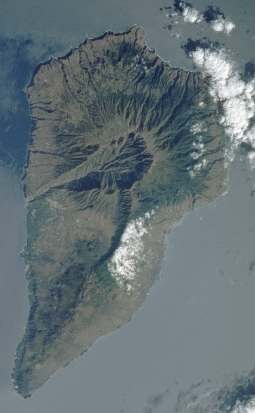
Space Shuttle Photograph
|
"At the northwest of the Canaries archipelago, a few hundred miles from the coast of Africa, lies the island of La Palma, also known as La Isla Bonita, because of its extraordinary natural beauty." |

Space Shuttle Photograph |
I quote from the description on the Isaac Newton Group site. Rather than I re-invent the wheel, I suggest you visit the site here for loads of information on this wonderful island. I and two friends spent 10 days there from 9th June, staying at a villa a few miles south of Tijarafe on the West side of the island (map here).
The island is of course the home of some of Europe's largest professional telescopes, situated there because of the excellent seeing conditions and clear skies at the 2400 metre height of the Observatories. But apart from that obvious interest for amateur astronomers, the Island itself is extraordinarily beautiful with dramatic landscapes and contrasting vegetation.
Our villa was situated at 700 metres above sea level, and although at times, particularly in the afternoon, we experienced cloud cover, fortunately on most nights the skies cleared and we were blessed with superb sights of the Milky Way glowing brightly and stretching across the sky from horizon to horizon. The 28 degree latitude, some 26 degrees further south than my home meant that much of the heart of the Milky Way was visible, with dramatic views of Scorpius and Sagittarius, never seen from North East England.
The villa was owned and managed by Göran Hosinsky, who worked for many years as an engineer at the Swedish Solar Telescope on La Palma. Indeed he was involved with researching the site and installation of the telescope and eventually married and settled in La Palma. He lived at first in the villa, but later built a larger house next door, then made the villa available to let. He was also an enthusiastic amateur astronomer and had some astronomical equipment which was made available to guests, but although it was limited for astrophotography and we had some problems with bad connections and broken wires, nevertheless I was able to capture some beautiful images. The most striking aspect of the imaging experience was how it was possible to resolve myriads of fainter stars which at home would have merged into background noise and 'mush'. The seeing was in general at least twice as good as I ever experience in England. I learned several years later that Göran sadly died on January 25th 2014, but the villa, 'Casa Rosabel', is still (2025) available for holidays.
|
This photograph of the most southern section of the Milky Way visible from our villa is a stack of just two frames taken with my Canon 350D and 17 mm lens on a driven mount. The faint black bars to the left are overhead wires, blurred by tracking during the 5 minute exposures. Even on La Palma, despite local laws, there is light pollution , in this case from the town of Los Llanos situated a few miles to the south. But it's all relative, and although visible in this wide angle shot, it was not noticeable to the naked eye, nor did it affect the longer focal length shots. The medium size image (click on the thumbnail) shows with 'mouseover' the constellation figures and most of the targets photographed below. This image and those of M6 and M7 below were used in the July 2007 BBC TV 'Sky at Night' programme. This image was also used again around November 2009 (not sure of the month), in June 2010, in February 2011 and yet again in March 2012 and August 2012! |
 |
|
One of the prime targets on my list was the stunning Centaurus A galaxy (NGC 5128) with its massive dust lane. Unfortunately due to the limitations of the drive I was using the image is not as detailed as I would have hoped. Artemis 285 and Meade 10" LXD55 Schmidt-Newtonian telescope (f4). Luminance 7 x 3 minutes, RGB each 5 x 90 secs binned 2x2. Although it looks as though this image is vignetted, it ain't! See this image from the ESO. But because I only had limited data, mine is rather 'noisy' in comparison! |
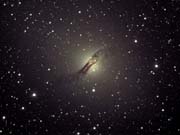 |
|
No visit to more southern latitudes would be complete without observing NGC 5139, Omega Centauri, the largest and brightest globular cluster in our Galaxy. My little William Optics ZS66 refractor and Artemis 285 proved an ideal combination, and the lighter weight on the mount guided admirably for this and other WO images. Luminance 13 x 1 minute, RGB each 6 x 1 minute. Yes - only 1 minute exposures were required - the sky is so clean and contrasty. This image was published in the April 2009 Sky at Night magazine in a 'Deep Space' special feature. |
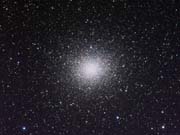 |
|
Messier 83, also in Centaurus is almost impossible from my latitude, reaching a maximum altitude of only 5 degrees. But decently high from La Palma, and a beautiful galaxy to image. Again limited by the equipment - its relatively small size necessitated using the 10" reflector. Nevertheless I've managed to get an impression of its beauty and barred spiral structure. Luminance 17 x 1 min, RGB each 5 x 1 minute, all binned 2x2, so only a medium sized enlargement. |
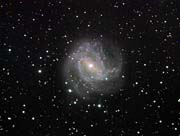 |
|
Messier 4 in Scorpius lies just outside the edge of a large field of nebulosity surrounding the red giant star Antares. And a nearby Globular Cluster, NGC 6144 is also in the image, but this time partly obscured by the nebulosity. Again the remarkable seeing conditions on La Palma enabled me to capture all this with quite short exposures. Artemis 285 with WO ZS66, Luminance 14 x 2 minutes, RGB each 5 x 2 minutes. This image featured in The Sky at Night BBC TV programme, August 2012 |
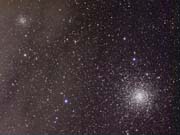 |
|
There are some particularly beautiful bright open clusters embedded in the star filled central Milky way which were classified by Messier. Messier 6, the 'Butterfly' cluster in Scorpius is one of these. It was just visible to the naked eye, and imaged very nicely with the Artemis and ZS66. Luminance 8 x 2 minutes, RGB each 4 x 2 minutes. This image featured in the 'Deep-sky Wonders' section of the July 2011 Sky and Telescope magazine. |
 |
|
Messier 7 - Ptolemy's Cluster in Scorpius is another particularly bright and large open cluster. At magnitude 3.3 it was clearly visible to the naked eye. It has an interesting dark patch towards the south, and the small 10th magnitude globular cluster NGC 6543 is just visible at the right centre edge of the image. Artemis 285 and ZS66. Luminance 16 x 1 minute, RGB each 6 x 1 minute. |
 |
|
Although the Trifid nebula, Messier 20 in Sagittarius (and M8 below) unlike M6 and M7 above are just high enough to image from my home, nevertheless they are still difficult. A very different story in La Palma, and the excellent sky conditions allowed for much fine nebulosity to be captured with only short exposures. Artemis with ZS66. Luminance 11 x 1 minute (yes - only 1 minute!!), RGB each 6 x 1 minute. This image featured in The Sky at Night BBC TV programme, August 2012 |
 |
|
On the last night of the holiday I wanted to get a good image of M8. While waiting for it to rise, I visited Markarian's chain in Virgo, which was getting low in the West. Unfortunately some mist developed over the sea and prevented me from obtaining colour. But a pleasing monochrome image, with numerous faint small galaxies visible. Artemis 285 with ZS66. 15 x 2 minutes. |
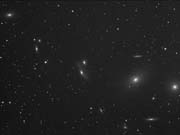 |
|
Then on to Messier 8 - the Lagoon Nebula in Sagittarius. I'd previously imaged it with my TMB 105 refractor from COAA in Portugal (here) , but without colour, and a smaller field of view than with the ZS66. This emission nebula benefits from use of a Hydrogen Alpha deep sky filter, so the Luminance is 11 x 2 minutes Ha, RGB each 3 x 2 minutes. It'll do! This image was 'Image of the Month' in the September 2007 issue of Practical Astronomer, and featured in The Sky at Night BBC TV programme, August 2012 |
 |
|
At the base of the 'stinger' in Scorpius there appears a bright patch to the naked eye. In binoculars it resolves to a trail of stars leading to a smallish but bright cluster, NGC 6231 - the 'Table of Scorpius'. And here it is, Artemis 285, ZS66, Luminance 11 x 1 minute, RGB each 5 x 1 minute. |
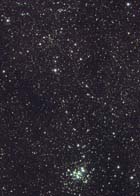 |
|
During our visit the New Moon put up a nice show, and the steady sky allowed crisp images - I couldn't resist going for the Earthlight. Artemis with ZS66. |
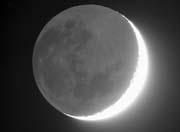 |
As I mentioned above, the Island of La Palma is dramatically beautiful, and houses major Observatories. We were fortunate in obtaining a guided tour of the Observatories, so here are some general holiday pics and a selection of photographs taken at the Observatories.
|
Although La Palma is a relatively small Island, only 706 Square Kilometres, not much larger than the Isle of Man (572 Sq. Km) it's central volcanic peaks give it the steepest height rise for its size of any other land mass on Earth. The flanks of the mountains are liberally spattered with ravines, many of which cross the road encircling the island. Rather than using expensive bridges, the roads wind in and out of the ravines, so although the Island is little more than 40 Km long, the road distance from North to South is almost twice this, and speeds are limited by the many blind corners and short straights. The largest ravine is the main erosion channel from the caldera, lying between Los Llanos and Tijarafe, where the road climbs almost 500 metres in a few kilometres. This photograph shows the hairpin bends as the road drops into the ravine from Los Llanos then climbs up to the viewpoint cafe of Mirador El Time |
 |
|
The views from the cafe are magnificent, looking over the towns of Los Llanos and Tazacorte to the South end of the Island. |
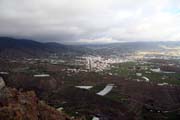 |
|
Where the main ravine meets the sea, there is the small fishing port of Puerto del Tazacorte, developed as a tourist area with hotels, restaurants and a small black sand beach. Nicely decorated with flower beds and shrubs. Here are Gordon and Paul enjoying the scene! |
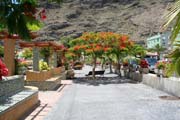
|
|
In the cliffs overlooking the village there are abandoned cliff dwellings |
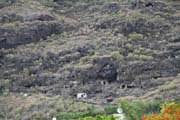 |
|
Near the road junction where the road to the port joins the main road between Los Llanos and Tijarafe at the bottom of the ravine there stands a most attractive church, Nuestra Senora de las Angustias (Our Lady of Sorrows), finished in the Canarian style with stones left showing through the white stucco finish. |
 |
|
As the road climbed to Mirador, it afforded magnificent views up into the main crater, Caldera de Taburiente. |
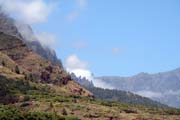 |
|
The villa where we stayed was also typically Canarian, and most attractive. Myself, Paul and Gordon.
We weren't the only residents! |
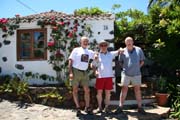
|
|
The observing area was situated a short distance from the villa. Paul and Gordon imaging. |
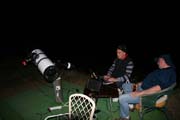 |
|
The villa had open views to the sea some 700 metres below, and gave beautiful views of Sunsets, often above low level clouds.
The Moon and Venus in late evening light and superbly clear sky. |

|
|
The interior of the Caldera is a national park, and mostly inaccessible except on foot. But there is an access point at a break in the rim on the southern flank, and a road up to it from El Paso, with a car park at the top at la Cumbrecita, 1287 metres above sea level. It offers wonderful views into the Caldera de Taburiente, right across to the highest point of Roque de los Muchachos at 2426 metres above sea level - the location of the Observatories.
A volcanic intrusion exposed by erosion.
The last snows of winter!
Part of the east ridge from the road up.
|
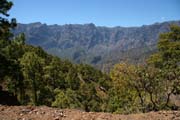
|
|
On the final Saturday of our trip, we drove up to the Observatory site, and commenced our tour of the Isaac Newton Group of telescopes at the William Herschel Telescope. And boy, is the dome big up close! There is detailed information on the Isaac Newton Group of telescopes here. |
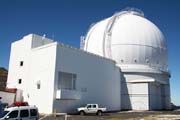 |
|
Inside, there was much to see. John gave us an excellent private tour of this and the other two telescopes of the ING, with much information not normally available to official tour groups. Many thanks, John for your kindness! Here's the telescope itself - doesn't look all that big...... |
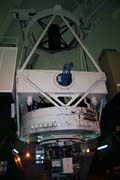 |
|
Until we stand under it! Gordon, Paul, John and myself. |
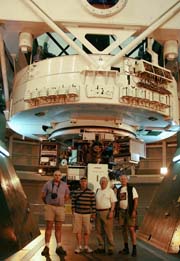 |
|
We were fortunate that an official tour came round while we were there, and the telescope was tilted and the mirror exposed. Here are the protective petals covering the mirror. |
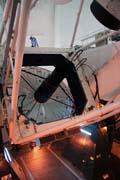 |
|
And the great 4.2 metre mirror exposed. |
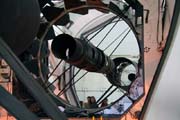 |
|
Me taking a photograph of the mirror and me! |
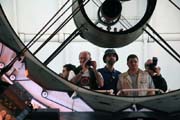 |
|
And a final view of the Dome |
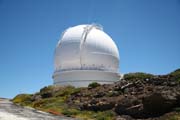 |
|
Then on to the Isaac Newton Telescope. |
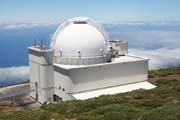 |
|
Two views of the telescope, showing the Right Ascension and Declination drives and sensor housings. It originally lived at Herstmonceaux in Sussex, England, but was eventually moved out to La Palma to take advantage of the excellent conditions. It took over two years for the Right Ascension bearings and drive to be re-engineered to withstand the stresses occasioned by the lower latitude of La Palma. All three Isaac Newton Group telescopes were manufactured by Grubb Parsons in Newcastle upon Tyne. The company sadly no longer exists. |
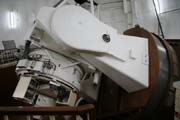
|
|
The 2.5 metre mirror partly exposed. |
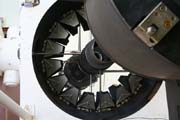 |
|
John filling the imaging cooler with liquid Nitrogen. Most becoming! |
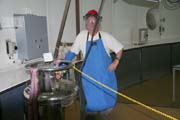 |
|
Finally on to the smaller Jacobus Kapteyn Telescope. |
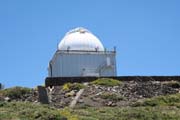 |
|
This nice little (!) telescope with its 1 metre mirror uses a single arm cross axis type mount. |
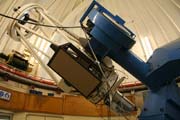 |
|
In order to show the whole telescope within the confines of the dome I had to combine two photographs, hence the rounded corners. Sadly this instrument is little used now due to financial constraints. |
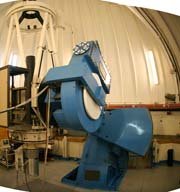 |
|
Here is a view showing all three Isaac Newton Group domes, and three other instruments. From left to right, the William Herschel Telescope, the Dutch Open Telescope, the Liverpool Telescope, the Swedish Solar Telescope, the Isaac Newton Telescope and the Jacobus Kapteyn Telescope. |
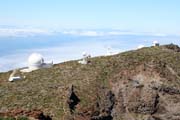 |
|
A much larger telescope is presently (2007) nearing completion - the Spanish Gran Telescopio de Canarias . This instrument has a 10.4 metre mirror made up of 36 hexagonal segments fully controlled by an active optics control system . Two views of the huge dome, the lower one also showing the Residencia lower down the slope which houses visiting astronomers on site. |
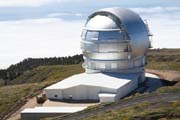
|
|
Only a short drive from the Observatories to a car park at the top of the mountain. So I didn't have to struggle to get there! |
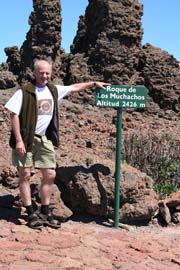 |
|
I believe Roque de los Muchachos means 'Rock of the Boys' And suspect these pillars of lava gave it that name. |
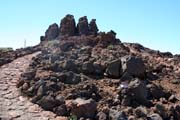 |
|
The processes of erosion have left weird formations exposed to view. This slab is about 4 metres high. |
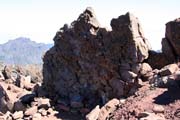 |
|
The views from the top are incredible. This is just a taster, looking into and over the Caldera and down the spine of the Island to the South. The dip in the ridge on the opposite side of the Caldera is the location of the car park at la Cumbrecita where the earlier photos were taken looking across to Roque de los Muchachos. |
 |